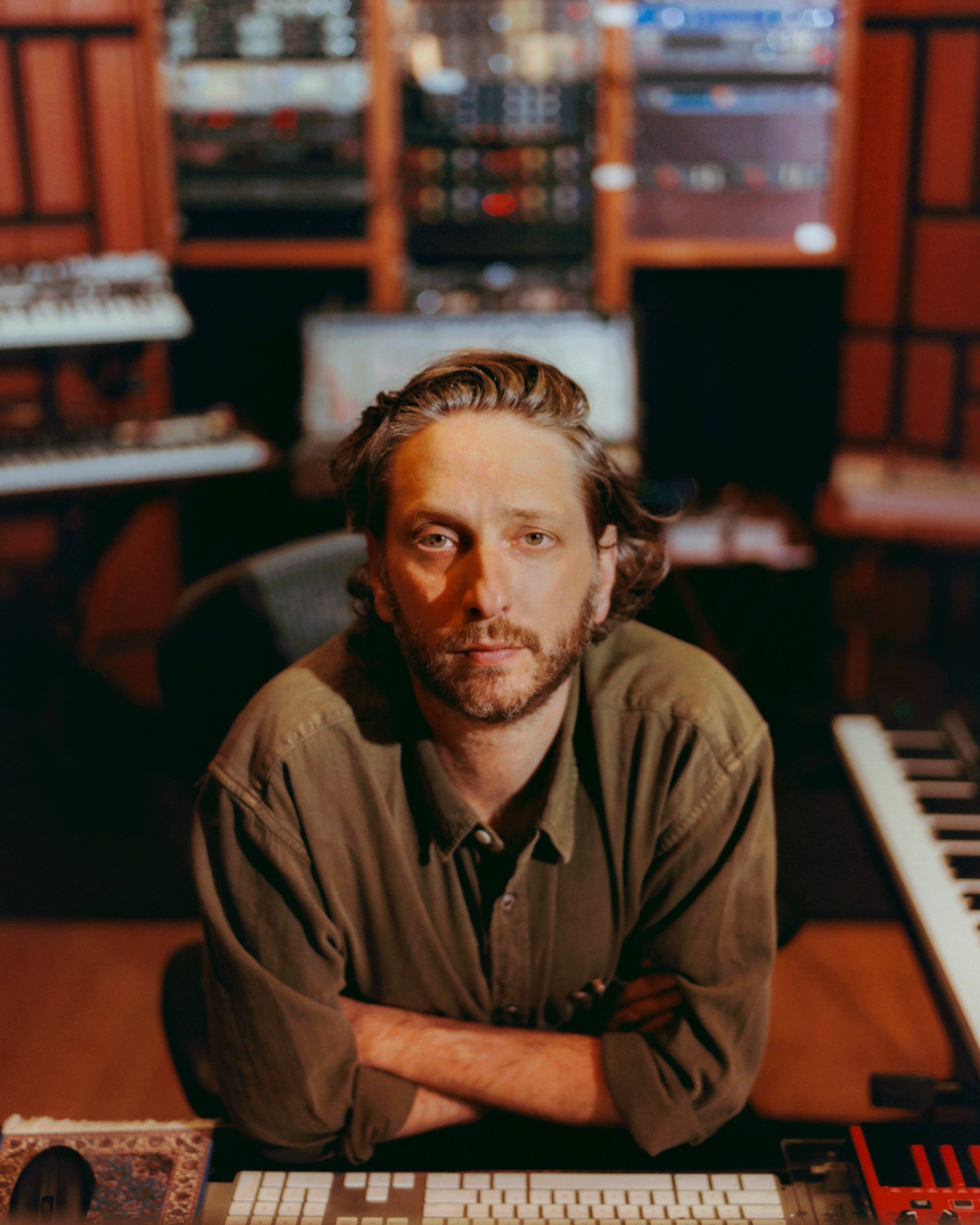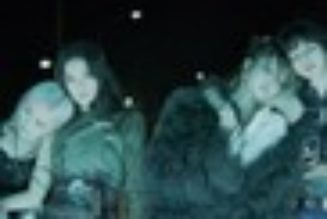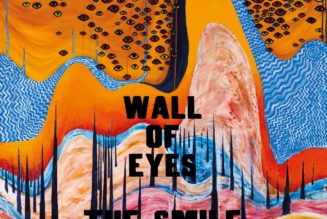The Emotionally Haunted Electronic Music of Oneohtrix Point Never

The video for “A Barely Lit Path,” the first single from “Again,” Daniel Lopatin’s tenth album as Oneohtrix Point Never, takes place on a dark road in a shadowy forest. Two CPR dummies wearing turquoise jumpsuits are strapped into a self-driving car. On the floor, there’s an artificial-intelligence manual, a book about understanding computers, and a copy of “Erewhon,” the 1872 satirical novel that imagines a future in which machines achieve consciousness. The dummies play chess; they nap. Their rubbery fingers reach across the seat for each other. It’s sweet. At some point, the road gets rough and the dummies start flopping around. A Stop button is affixed to the gearshift, but it’s just out of reach. One of the dummies starts to cry. The car is off course now, hurtling toward oblivion. The feeling is of utter helplessness in the face of assured disaster. Then—I don’t know. Maybe one of them gets to the button? The screen turns scarlet and sinuous, and begins to throb. You can hear something like a heartbeat. The sequence recalls both a prenatal ultrasound and the Rapture.
The song opens with Lopatin singing. His voice is fractured and heavy with effects:
Lopatin has built a career writing elegiac, otherworldly electronic compositions using computers, synthesizers, and digital scree; when he includes lyrics, they rarely feel confessional. But the plaintiveness of those last two lines is somehow devastating—the tenuousness of our connections, how earnestly we try to maintain them. The video was directed by the French artist Freeka Tet. “It’s the story of two lifeless characters,” Tet said. “One layer of meaning has to do with being sentient—life, death, forced entertainment, choices. Another is this kind of uncanny, romantic story. There’s the honeymoon phase, followed by the bumpy phase, and then the moment where you need to make a choice: Am I hitting the brake, or am I hitting the gas?” That feeling—liminality, ambiguity, unexpected tenderness—is consistent in Lopatin’s music. “The tragedy of our whole thing is that we’re very much contained in the unknown,” Lopatin told me one afternoon. “It’s part of us.” The goal isn’t to thrash against disconnection—or to panic, the old human instinct toward mastery and subjugation—but to somehow integrate it.
For more than a decade, Lopatin has been a highly regarded composer within electronic-music circles, and worshipped in certain corners of the Internet. But recently he has become the person mainstream pop stars call when their records are getting boring, rote, or predictable. Lopatin has collaborated with FKA Twigs, Caroline Polachek, Arca, Rosalía, Charli XCX, Anohni, and Nine Inch Nails, among others. In 2022, he produced “Sometimes, Forever,” Soccer Mommy’s third album. “He definitely has a knack for making things weirdly beautiful,” Sophie Allison, the singer-songwriter who performs as Soccer Mommy, told me. But the two chief creative partnerships in his life are with the film directors Josh and Benny Safdie, best known for the tense thrillers “Good Time” and “Uncut Gems” (Lopatin wrote the scores for both), and with Abel Tesfaye, who records as the Weeknd. Lopatin worked on three tracks for the Weeknd’s “After Hours” (2020) and co-executive-produced “Dawn FM” (2022), two of the best-selling pop albums of the decade. “It’s emotionally charged—even the stuff that sounds colder, more electronic, kind of icy. That’s the paradox,” the electronic musician James Blake said of Lopatin’s work. “Dan’s a sensitive person who’s also really interested in exploring the absolute upper limits of what’s possible creatively.”
One morning in mid-August, Lopatin and I met at his studio, a bright two-room suite, nicknamed the Sky Dungeon, on the fifth floor of a former industrial building in Williamsburg. A long wall was lined with synthesizers of various vintages; elsewhere, there were books, stacks of VHS tapes, and framed posters of Enya and of the 1972 sci-fi film “Solaris.” Lopatin, forty-one, is tall and easygoing. Though he recently composed and performed music for a Chanel runway show, he dresses in a low-key manner—“I basically just want to dress like I’ve been dressing since I was fourteen years old,” he said—and has taken to wearing what he calls “Italian senior-citizen shoes.” He was brought up in Winthrop, Massachusetts, an oceanside suburb across Boston Harbor from Logan Airport. His parents are Russian Jewish immigrants; before they left the Soviet Union, his mother taught music lessons and his father played a Roland Juno-60 keyboard in a rock band called the Flying Dutchmen. “When they came over, in ’82, they had to give everything up. Their roots were just annihilated,” Lopatin said. “They became very focussed on survival. My dad, because he had computer-science chops, found a way through into high tech. My mom, who didn’t, taught herself to code in the early eighties. She picked a piece of paper off a bulletin board that said ‘Learn C++’ or something. She said, ‘This is a lot like musical notation: it’s a symbol that’s in place for an idea.’ Code didn’t intimidate her.” She ended up in software development.
Both of Lopatin’s parents worked full time, and his sister was nine years older, so he was often alone, which perhaps accounts for the thread of alienation that runs through his work. (He is also the only American-born member of his family.) When he was six or seven, his dad brought home a personal computer. “I had never seen anything like it. It looked like the monolith from ‘2001,’ ” Lopatin recalled. “It was a Unix-based computer. It was beautifully designed—it looked like a crazy black cube. It was connected to a 28.8-Kbps modem, and it got me on the Internet.” He went on, “We had computers all the time and music all the time. That explains everything you need to know about me.”
As a preteen, Lopatin absorbed a lot of nineties alt-rock. “I was definitely grunge,” Lopatin said of his middle-school years, adding, “I had a beanie that I wrote ‘LOSER’ on. By high school, I was kind of over it. I was listening to a lot of geeky jazz-fusion records, prog records.” He drifted toward the local hardcore scene. “If somebody had a nominal interest in living their life in a nonconformist way, I was interested,” he said. Lopatin attended Hampshire, the famously progressive liberal-arts college in Amherst, and began making music using a sampler, his dad’s Roland, and a PC. In 2007, after a brief period living in Boston, he headed to Greenpoint, renting a bleak, moldering basement apartment and enrolling in the library-science program at the Pratt Institute. “The plan was to become a librarian and do music at the same time. I thought that would be a perfect life,” he said. “I’d read Derrida’s ‘Archive Fever’—talk about pretentious!—and I was, like, ‘This is sick.’ The human instinct to preserve and to document the past while it’s falling to rubble is one of the most romantic things I can possibly think of.”
In 2008, Lopatin met Carlos Giffoni, a Venezuelan musician who had recently started an experimental label in New York called No Fun Productions. “I thought, There’s nothing like this happening right now,” Giffoni said of Lopatin’s early cassettes. “He’s using polysynths and arpeggiation, composing experimental music, but using tones and noise, things that back then were not usually combined.” No Fun reissued “Betrayed in the Octagon,” Lopatin’s first official release, on vinyl. “We did three hundred copies, and they sold out within a couple of weeks,” Giffoni said. “Then he did an original LP for me called ‘Russian Mind.’ That sold out in two days. And then we decided, Let’s collect all this stuff and add some tracks.” “Rifts,” his first double album, became the label’s best-selling release. The ingenuity and general inscrutability of Lopatin’s work resonated within the scene. He put out two more albums on smaller labels (“Returnal,” in 2010, and “Replica,” in 2011) before signing with Warp, in 2013, and releasing “R Plus Seven.” By then, he had racked up three coveted Best New Music proclamations from Pitchfork.
At the time, “I was trying to use sounds that I kind of deemed chintzy, borderline offensive,” Lopatin told me. He often sampled TV commercials from the eighties and nineties, excavated from YouTube. “All this detritus, I wanted to make something cool with it,” he said. “Being a latchkey kid, my memories were of commercials I saw between programs. It’s not a point of pride—when people say, ‘Your music is nostalgic,’ I’m, like, ‘Are you fucking out of your mind? You think I like this shit? It’s garbage.’ But it’s the stuff of my life, whether I like it or not.” He paused. “It’s the way my brain is. I’m sensitive to ephemera. Maybe I was surrounded by people. But I can only remember the commercials.”
When Lopatin was still living in Boston, and working at a textbook-publishing company, he started making what he called “eccojams”—essentially, chopped-and-screwed remixes of treacly ballads, paired with videos that featured strange repeating imagery. The publishing gig was stultifying. “I was nothing,” he said when I asked what the job entailed. “I was a piece of furniture. I could just feel the life draining out of me.” Lopatin began uploading the videos to YouTube, and in 2010 he put out a hundred copies of “Chuck Person’s Eccojams Vol. 1” on cassette. “B4,” the most beloved of the eccojams, features a mesmeric sample of “The Lady in Red,” an awful song recorded by Chris de Burgh in 1986. On its own, de Burgh’s voice has a weird, cadaverous quality; when Lopatin loops an isolated bit from the chorus (“There’s nobody here!”) nineteen times in a little more than two minutes, it becomes a kind of surreal Mayday call, lonesome and eternal. The video features a reiterative graphic—a pulsing stretch of rainbow-colored highway—from Laser Grand Prix, an eighties arcade game. Watching it made me think of ancient Gregorian chants, and the droning, pentatonic laments of northern Greece, and certain Indian ragas, and, eventually, any sort of music that makes your vision blur, or gets the mind soft enough to see God.
Both the song and the video were assembled entirely from found material. Yet the release of “Eccojams” was also a Big Bang: it was the dawn of vaporwave, a genre of electronic music obsessed with aestheticizing relics of the recent past. Attempting to define vaporwave is sort of humiliating: like most Web-based phenomena, it deploys an idiosyncratic grammar that remains mostly inscrutable to anyone who has recently gone outside. The visuals tend to involve 3-D graphics, screen savers, dolphins, dead malls, VHS tapes, corporate training videos, bad graphic design, and Greco-Roman statues. The primary instruments are synthesizers and YouTube. There’s a kind of aching pathos to some of it. If you’ve ever wandered around a flea market and felt a peculiar pang after coming across, say, an inkjet printer from 2008, an old cable box, or an unopened Sony MiniDisc player, you know what I mean: the accelerated obsolescence of commercial technology can feel like a kind of memento mori. Nothing is relevant forever.
Lopatin is credited as one of vaporwave’s earliest practitioners; he is probably its inventor. The genre had an oddball moment in the sun in 2012, when Rihanna performed her hit “Diamonds” on “Saturday Night Live” before a projection of vaporwave-ish graphics: a weird neon peace sign, a ceramic bust, a checkerboard, a spinning globe, fractals, palm trees. The fact that “Diamonds”—a pop ballad—is not a vaporwave song, in any sense, doesn’t matter. Boundaries, systems, context: these are also relics of the past.
One Friday afternoon, Lopatin and I met at the Storm King Art Center, a five-hundred-acre sculpture garden in the Hudson Highlands, about an hour from Manhattan. The center’s collection includes large-scale pieces by artists like Isamu Noguchi, Alexander Calder, Andy Goldsworthy, Richard Serra, and Louise Bourgeois, plunked onto grassy knolls. That day, the paths were filled with couples, presumably from Brooklyn, presumably giggling through a third or fourth date. Lopatin and I sat under a tree near “Lockport,” a seventeen-foot-tall, Crayola-blue post-and-lintel aluminum structure built by Lyman Kipp, an American sculptor, in 1977. Kipp was inspired by the skeletal shadows of half-finished buildings at construction sites, and the piece’s final form felt transitional, fluctuating, changing with the light and the slant of our approach. “A really exciting part of technology is that you can metaphorically experience one thing from many different angles,” Lopatin said. “And that’s sculpture, too. Being able to look at things a million different ways.”
Lopatin feels more indebted to film and sculpture than to music—he once asked me, quizzically and sincerely, “Do you sit in your house and listen to records?”—though he also harbors what he describes as “active vitriol” toward the art world, which can feel cloistered and inaccessible. “Art itself shouldn’t have a specialized language,” he said. “Sculpture, especially, seems really, really metaphorically aligned with music.” He continued, “There’s this artist named Gordon Hall. I went to college with them, and we were very close. I went to a lecture of theirs many years ago, at the SculptureCenter, in Long Island City. Gordon’s, like, ‘Here’s a chair,’ and showed a picture of a chair. And then it was, like, ‘Here’s an abstract sculpture.’ The chair, it infers the human body. So what body is inferred when you look at an abstract sculpture? There’s an identity aspect to that part of the work for Gordon, but there’s a really universal lesson in there as well, which is: What can new forms of art teach us about new worlds we want to build, new bodies, whatever? I saw that chair and I saw that sculpture and I said, ‘Yep. I’m in the sculpture business. I’m not in the chair business.’ ”
For the cover of “Again,” Lopatin commissioned an original piece by the Norwegian sculptor Matias Faldbakken after seeing his “Locker Sculpture #2,” in which a row of collapsing metal lockers are squeezed together by ratchet straps. It’s as though the lockers were being hugged to death. “Again” features an array of outdated computer speakers in the same state. “I was spending so much time at thrift stores, and I kept seeing these computer speakers in the little electronics section. It’s a useless section. But somebody had lovingly put these speakers out and wrapped them in tape,” Lopatin said. “It reminded me of Matias’s sculpture, so I took a chance and introduced myself, and asked him if he thought that it was possible to melt plastic the way he had hammered the metal. He was, like, ‘There’s only one way to find out.’ ”
Lopatin’s work might be tethered, in literal ways, to the past, but the effect is not familiar. It’s eerie and inconstant—more dream than memory. Around the time of “R Plus Seven,” Lopatin stopped relying so heavily on found sound. “I didn’t want to rearrange other people’s textures and let that show me what the music was gonna be,” he said. The records that followed (“Garden of Delete,” in 2015; “Age Of,” in 2018; “Magic Oneohtrix Point Never,” in 2020) each have a particular sonic quality and conceptual framework. “Garden of Delete” is about a “molting teen-ager” who is visited by an alien bearing a USB stick; “Age Of” is about the chaos and peril of the Trump era; “Magic” is a sweeter, gentler album, as close as Lopatin has come to sentimentality. In 1962, the film critic Manny Farber coined the label “termite art” to describe work that “goes always forward eating its own boundaries,” an idea that feels especially applicable to Lopatin, who has a tendency, maybe a compulsion, to invent and then dismantle new forms. “I’m not gonna regurgitate old ideas just because they’re working. I distrust my own taste,” he said, laughing. “Making one record over and over is just a little too self-assured.”
Lopatin first met the Safdies in the mid-twenty-tens. “This is the upshot in New York—you’re all kind of in the soup together,” Lopatin said. “You’re aware of other people doing interesting things. They invited me over to their offices in midtown. There’s this one brother—crazy, looking insane, I can barely see his cheeks, they’re just covered with hair. He’s handsome. I like him! And then the other guy, he’s well put-together, serious, I think he was wearing a fleece. Gigantic ‘Akira’ poster on the wall. I just felt immediate kinship. That doesn’t really happen that often.”
Josh Safdie recalled, “I briefly worked at a video store in Little Italy, and a CD-R sat on the player with the name of a friend who I used to cruise electronic music with. This was probably around 2008. Track twelve took the shop into a new place. I texted my buddy, ‘Who’s track twelve?’ and he wrote back ‘Oneohtrix.’ It was one of those words that you read but don’t say aloud. More like an image.” In 2015, when the brothers were looking to score “Good Time,” they reached out to Lopatin. “He showed up wearing a Boston Celtics hat, which was alarming, but I instantly felt like I was in an infinite hang session,” Josh Safdie said. “He’s a very deep guy, and yet everything is possibly a joke.”
Safdie and Lopatin wrote together at Lopatin’s studio, in Brooklyn, often working into the early morning. “We’d pirate plug-ins and cruise through every sound. After a feeling or a mood is set for a cue, often objects in the frame might inspire a note or a melody—we’d find ourselves synching a metallic sound to a highway overpass briefly wiping across our screen, or chimes that corresponded to a glimmer of light,” Safdie said. “I learned alongside Dan that writing a score and producing it is like a whole other film hiding inside the film. I think we’re both looking to take off, and by that I mean that we’re in search of some destination outside time and place. We’re both entirely interested in the moment and in getting lost in it. We also both suffer from anxiety, and music—in particular, electronic music—can tap right into that.”
Lopatin met Tesfaye through the Safdies, who cast the Weeknd in “Uncut Gems.” “Ever since we met, we were just inseparable,” Tesfaye told me. “He has a lot of heart. And you hear it in his music. Even in his most avant-garde stuff, you hear the soul in it.” He added, “I think together we’ve created some of the most genre-bending music of my career.” The Weeknd’s “Dawn FM,” which was co-executive-produced, in 2022, by Lopatin, Tesfaye, and the Swedish hitmaker Max Martin, feels like a spiritual rejoinder to “Magic Oneohtrix Point Never”—both records are obsessed with crackly, outmoded FM radio as a comforting but almost supernatural force. “Dawn FM” is full of strange and slippery moments (pitch-shifted vocals, arched melodies, warped synthesizers, existential duress) that are captivating to encounter on the pop chart.
When the Weeknd was tapped to perform at the Super Bowl halftime show in February, 2021, Tesfaye asked Lopatin to be his musical director. “He said, ‘We’ll figure it out.’ That’s my language,” Lopatin said. The performance still feels singular among halftime shows. It was a dark and paranoid moment for the American psyche: Covid was raging, and the Capitol had been breached the month before. Because of the pandemic, more than half of Raymond James Stadium, in Tampa, was occupied by cardboard cutouts. Tesfaye bounced around a hall of mirrors filled with avatars of himself, their faces bandaged, singing about love as an utterly obliterating force. Then, suddenly, he was bopping around a platform, grinning, while fireworks went off, singing a song about romantic bliss. It was a thrilling mix of perverse and sunny.
When I asked Lopatin if he was on the field that night, he said, “There’s this big pirate ship behind one of the end zones, and I was in the pirate ship.” He continued, “My therapist calls me ‘Motherfucker.’ We have a whole thing. He was, like, ‘Motherfucker’—he’s from Texas—‘Motherfucker, I’m old, I’m a bag of bones. You’d better bring me something back from that pirate ship, because I love Tom Brady!’ ” He laughed. “I got all this thread from the rope holding up the fake sail, and I put it in this little Plexiglas thing for him. If you’re gonna steal, steal a tiny thread. Steal the smallest thing you can find.”
Lopatin finished “Again” in March, in a rented house in Accord, New York. The record closes out a three-album run in which Lopatin has remembered, misremembered, and invented his own coming of age. “Again” was influenced by post-rock, a stark genre that coalesced in the early nineties and draws heavily from punk and experimental music. The album features contributions from Jim O’Rourke and Lee Ranaldo, erstwhile titans of the post-rock scene, and is “set,” in a sense, in the early two-thousands, a period in which Lopatin was “not having corporate rock inflicted on me but was finally at an age where I was making my own choices,” he said.
Lopatin was drawn to post-rock’s particular mix of scrappiness and sophistication, how it pulled from the avant-garde but distorted those influences, in ways that could make the music feel feral. Something about it—post-rock can be cold and boring, yet also unpredictable—reminded him of artificial intelligence. “We’re living during this paradigm shift where everyone’s thinking about the soulfulness, or relative un-soulfulness, of A.I.,” he said. OpenAI’s Jukebox—which the company describes as “a neural net that generates music”—is credited on two tracks on “Again”; Lopatin also used Riffusion (which converts a text prompt into an image and then translates that image into sound) on one song and Adobe Enhanced Speech (an A.I. tool that cleans up low-quality audio) on two others.
Lopatin’s work with A.I. owes at least a theoretical debt to the French composer Edgard Varèse, who was bored by the limitations of acoustic instruments, and who, in 1936, described “the electronic” as “our new liberating medium.” Varèse thought that only electronic instruments could effectively “satisfy the dictates of that inner ear of the imagination,” and dismissed fears that these new modes might challenge composition. “Anything new in music has always been called noise,” he wrote. Lopatin finds most of the hand-wringing about A.I. to be silly. “It’s over, we’re all gonna die, the machines are coming to get us,” he said, laughing. “That’s really boring. What’s more interesting for me is seeing how A.I. fails.” He went on, “When it fails, which it does a lot right now, it creates these insinuated arrangements that don’t sound anything like any music I’ve ever heard. It’s so broken that I can only compare it to, like, the most extreme music I’ve ever heard in my life.”
A.I.’s wonkiness—all of these networks are still in their nascency—forced Lopatin to reëxamine his most instinctive and well-worn habits. “It reminds me a lot of Paul Schrader’s transcendental-cinema thing,” Lopatin said. “He always talks about how there are films that are formulaic and ones that aren’t. The ones that aren’t do weird things with time. They dwell a little bit too long on the wrong object, like a door after someone has passed through it. You’re usually following the person, but now we’re staying on the door. That’s what A.I. is actually doing really well. What it’s not doing very well is following the person.” He continued, “When I first started using A.I., I would basically just give it metadata. I’d say, ‘I want you to make a Smashing Pumpkins song.’ It tries, and it can’t. That’s a lot like me.”
One recent afternoon, Lopatin and I met at the public library in Katonah, New York, a leafy suburb in Westchester County. What were we doing there? I’m not sure either of us could say. Lopatin kept forgetting the name of the town. It had come up that it would be funny, maybe germane, to meet at a library. “Ideal hang sesh,” he’d texted. “Mark Twain ass.” Lopatin is good on his phone: clever, charming, fast. One morning, he texted me a song by the singer and producer Marcus Brown, who records as Nourished by Time. The track, “Shed That Fear,” features a chipper but celestial synth line that made me feel like my body was a helium balloon recently let loose by a child. Lopatin described it as “Arthur Russell meets Daft Punk but deep R. & B.” and the “only new music I absolutely swear is next level.”
We walked around town for a while, past rows of neatly maintained houses and driveways with children’s bikes splayed on the pavement. The dissociation and the ambient loneliness of the Internet seemed far away. Over lunch, I needled Lopatin a little about his personal life. “What if we just say . . . I’m not a eunuch?” he suggested. Lopatin is generally interested in obfuscation, and in what he refers to, more formally, as “confusing the ear.” He likes synthesizers, he said, because they monkey with a person’s “sense of stability.” Even the name he records under—Oneohtrix Point Never—is a mondegreen, a mishearing of a radio-station call (Magic 106.7) from his youth. When it was suggested that perhaps there is an element of tricksterism to his work, he laughed. “That’s Oneohtrix—‘one oh tricks,’ ” he said. “Ones and zeros, tricking out computers, the manipulation of sound. I like to absorb factual things and make them fictitious. That’s also a trickster’s move: to introduce doubt into the thing.” He kept enthusiastically recommending a BBC program called “Fake or Fortune?,” in which experts attempt to determine the provenance and legitimacy of various art works.
I got it. A little bit of mystery is central to the project. It’s not so much that Lopatin wants to be enigmatic as it is that he doesn’t believe in the sanctity of fixed narratives. A photograph, an interview, a memory, an Instagram post—it’s all a little bit unstable, a little bit untrue. He is more drawn to an ethos of transubstantiation, in which things can become other things.
The American primitive guitarist John Fahey described the Mississippi blues singer Charley Patton, who recorded between 1929 and 1934, as “a pioneer in the externalization, through music, of strange, weird, even ghastly emotional states.” Patton’s lyrics—which toggled between nonsensical and bawdy, delivered in a carnal bark—weren’t entirely his. Like many bluesmen, Patton used what historians call “floating” verses—remembered (or, more likely, half-remembered) bits of other songs, which he picked up on the street, in bed, around a campfire, or in a juke joint, in an era before music was recorded and therefore frozen. Back then, performers were always collectors: of sounds, melodies, grudges, psychic states. The country blues was a wildly inventive idiom, but it was also rooted, like many vernacular traditions, in assemblage.
Musically, Oneohtrix Point Never could not be more distant from the country blues, but something about Lopatin’s style reminds me of Patton and his itinerant cohort. Lopatin’s music is built to make his listeners think about different things. “Again” eventually had me reconsidering my childhood, satellites, slow dancing, driving over a bridge in a new car, iPods, the lewd “No Smoking” ad that used to run before movies in the eighties, the spoken intro to Prince’s “Let’s Go Crazy” (“In this life, you’re on your own”), Philip K. Dick, and, perhaps most of all, a line from Jack Spicer’s 1962 poem “Three Marxist Essays.” (“They know that which runs this country is an IBM machine connected to an IBM machine / They never think of using their knives against its aluminum casing.”) Lopatin’s best songs build a space—uncanny, warped, almost purgatorial—in which various eras and ideas, both dead and alive, can speak to one another.
Lopatin told me that he almost always thinks idiomatically. “Oh, this sounds like this. This kind of makes me think of this,” he said. “I’m building a world of inter-referentiality. And then I can start collapsing some of those idioms on each other. I think that’s my Gen X, postmodern side. I just like making crazy collages.”
It seems possible that in the past few decades quantum leaps in technology have led to the creation of new—what? Feelings? Engaging with one’s smartphone requires accepting an endless stream of simulacra; we scroll, gently submitting to an amorphous, floaty sense of connectivity and engagement. The artifacts of our youths, once relegated to the wormhole of memory, are here, now, on our phones. We are constantly being confronted by the gulf between what’s real and what’s less real. Oneohtrix Point Never speaks directly to that new sensation—the ease and exhilaration of it, but also the hazy, sourceless ennui that settles in when someone invests too much time in an ersatz and disembodied facsimile of life. When I asked the critic Simon Reynolds, who wrote about Oneohtrix Point Never’s earliest releases in his 2011 book, “Retromania,” what sorts of feelings he thought Lopatin’s records evoked, he said, “I’m not even sure I can pinpoint what the emotions are. Often it’s like strange new affects of the future.” It’s hard to think of another contemporary musician who addresses the experience of hyper-modernity—of living and dying on the Internet—with the same precision or compassion. Lopatin has found a way to make the fragmented experience of our present era not just beautiful but true. ♦








